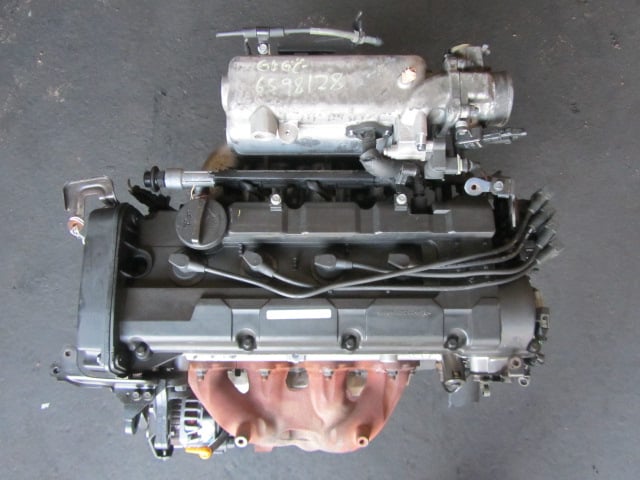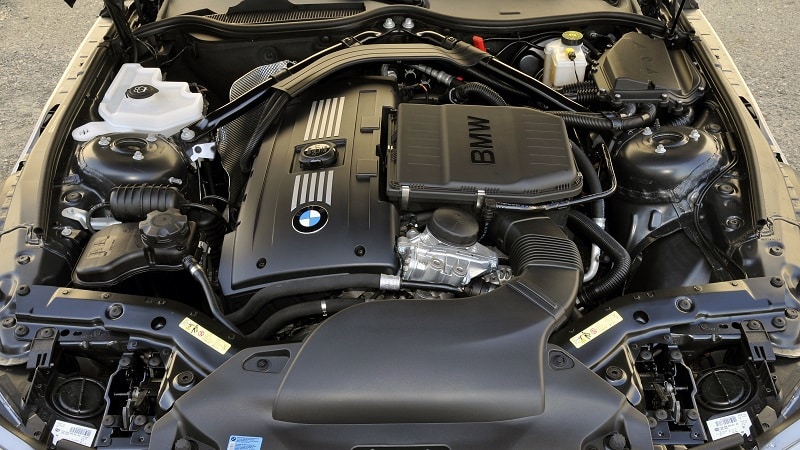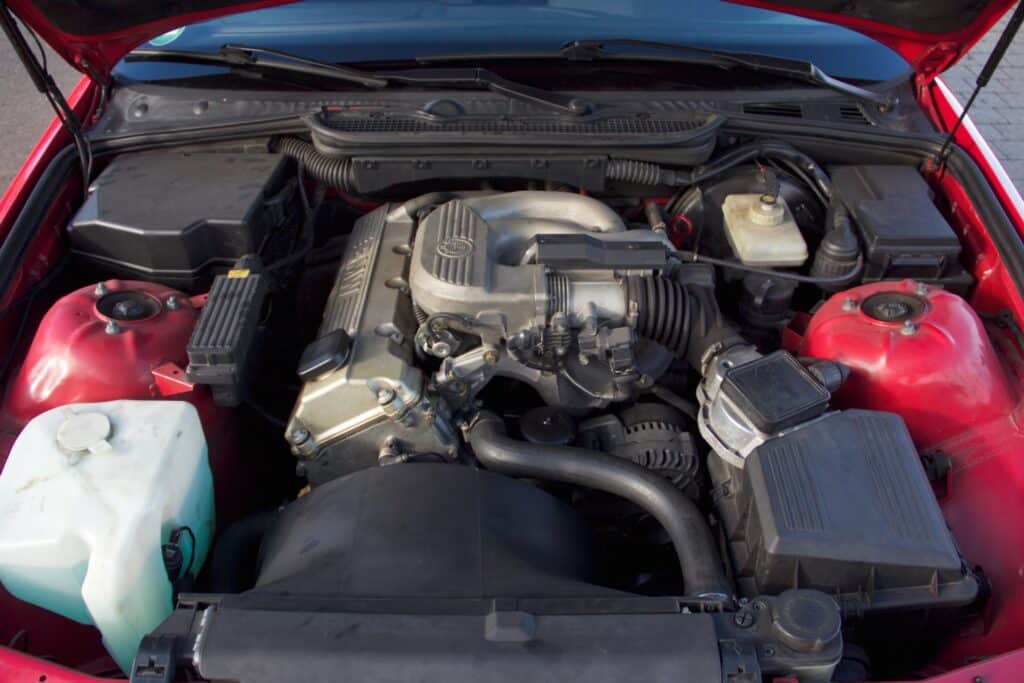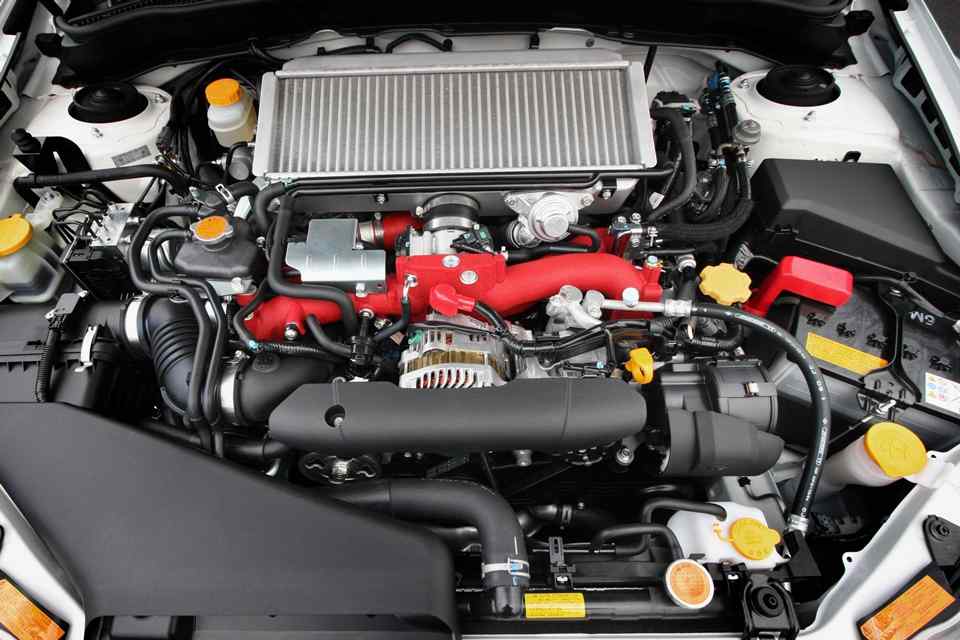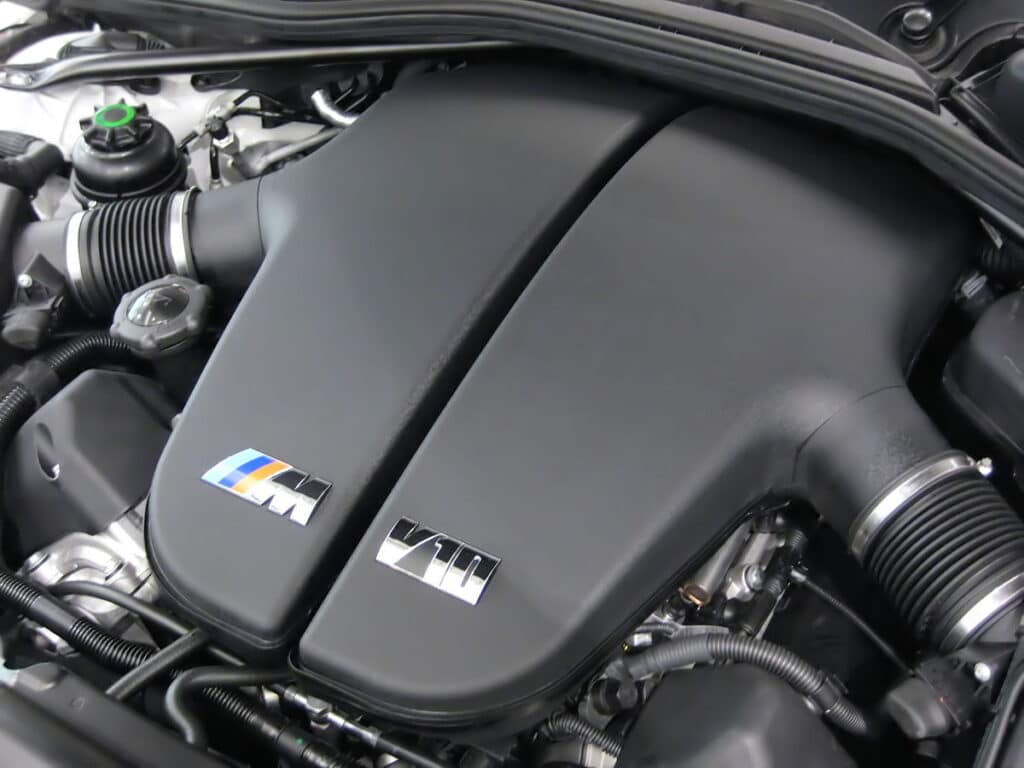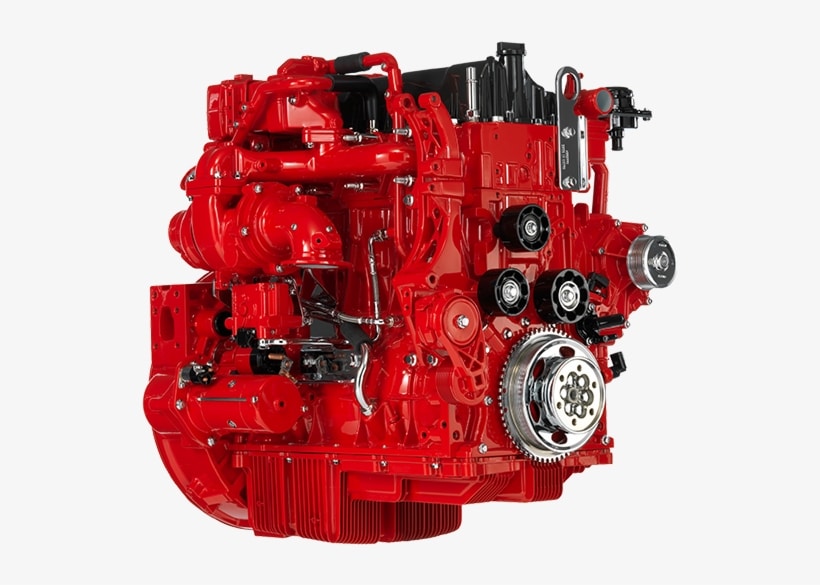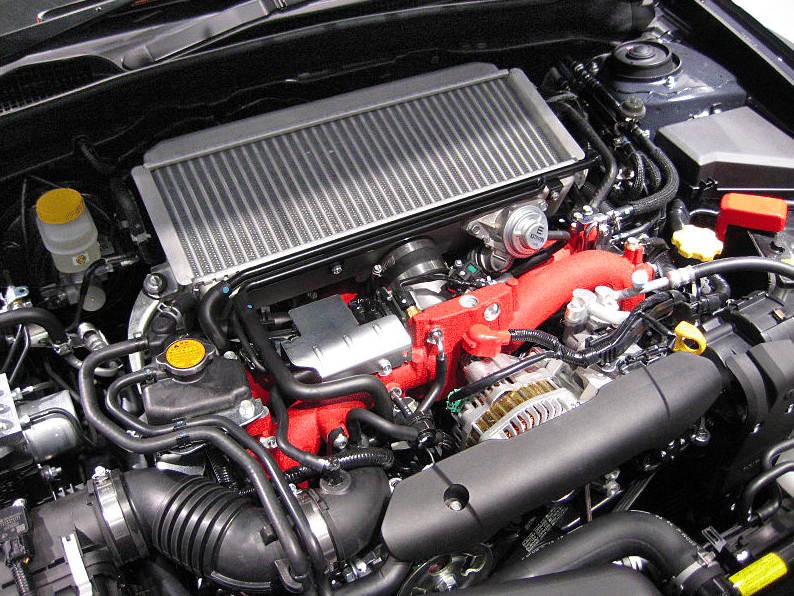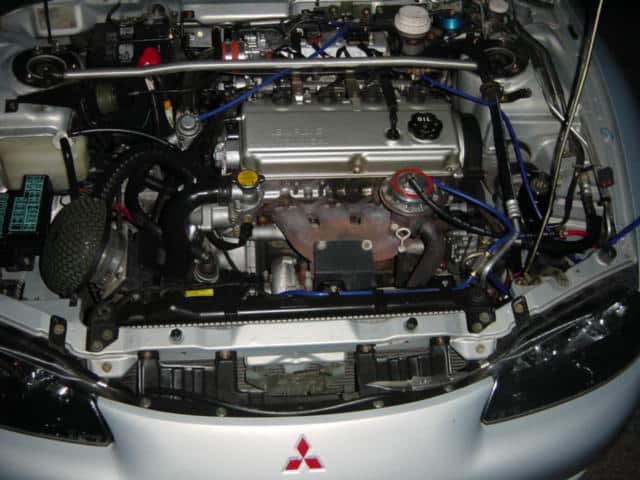The Mitsubishi 4G63 engine first roared to life in the 1980s, marking the beginning of its journey as one of the most revered engines in the performance community. Renowned for its robust construction and ability to produce significant power from a 2.0-liter, four-cylinder configuration, the 4G63 quickly became the go-to engine for enthusiasts and tuners alike.
Its iron block, alloy head, and turbocharged aspiration delivered thrilling performance and ensured remarkable durability. Whether it was dominating the rally stages or cruising on the street, the 4G63 engine has always been synonymous with reliability and adaptability.
The legacy of the 4G63 is built on a foundation of unyielding performance and steadfast reliability. It powered the legendary Mitsubishi Lancer Evolution series through ten generations, each iteration pushing the boundaries of what a street-legal rally car could achieve.
The 4G63 has seen victories on the grueling tracks of the World Rally Championship, etching its prowess into the history books. Its ability to withstand high levels of boost and modifications without compromising reliability is a testament to its design and engineering.
This engine has survived and thrived in the most demanding of environments, from the racetrack to the daily commute.
4G63 Engine Specs
The Mitsubishi 4G63 engine is an engineering marvel that has been the cornerstone of Mitsubishi’s performance lineup. This section provides an analytical look at the specifications that have made this engine a legend.
| Specification | Detail |
|---|---|
| Engine Code | 4G63 |
| Configuration | Inline-4 |
| Displacement | 1997 cc |
| Bore x Stroke | 85.0 mm x 88.0 mm |
| Compression Ratio | Varies (8.8:1 to 9.0:1) |
| Horsepower | 230 hp to 286 hp |
| Torque | Up to 289 lb-ft (391 Nm) |
| 0 to 60 mph | Approx. 4.5 to 5.7 seconds |
| Top Speed | Limited to 155 mph (250 km/h) |
| Valvetrain | DOHC, 4 valves per cylinder |
| Turbocharging | Equipped in most models |
| Fuel System | Multi-point or ECU injection |
| Induction | NA or Turbocharged |
Engine Displacement and Configuration
- Engine Code: 4G63
- Configuration: Inline-4
- Displacement: 1997 cc (2.0 Liters)
- Bore x Stroke: 85.0 mm x 88.0 mm
- Compression Ratio: Varies by model (e.g., 8.8:1 in the Evo I-III, 9.0:1 in the Evo IV-IX)
Power Output
- Horsepower: Ranges from 230 hp to 286 hp in stock form (varies by model and market)
- Torque: Up to 289 lb-ft (391 Nm) in the Evolution models
Performance Numbers
- 0 to 60 mph: Approximately 4.5 to 5.7 seconds (varies by model and modifications)
- Top Speed: Electronically limited to 155 mph (250 km/h) in most models
Additional Technical Features
- Valvetrain: Dual Overhead Cam (DOHC), 4 valves per cylinder
- Turbocharging: Equipped with a turbocharger and an intercooler in most models
- Fuel System: Multi-point fuel injection or Electronic Control Unit (ECU) controlled injection in later models
- Induction: Naturally aspirated or turbocharged options
The 4G63 engine’s prowess is not just in its numbers but also in its ability to be tuned and customized. It has strong aftermarket support, allowing enthusiasts to push the engine far beyond its factory specifications. Whether it’s for drag racing, rallying, or simply enhancing the driving experience, the 4G63 remains a popular choice for tuners worldwide due to its impressive balance of power, durability, and potential for upgrades.
Mitsubishi 4G63 Engine Design and Features
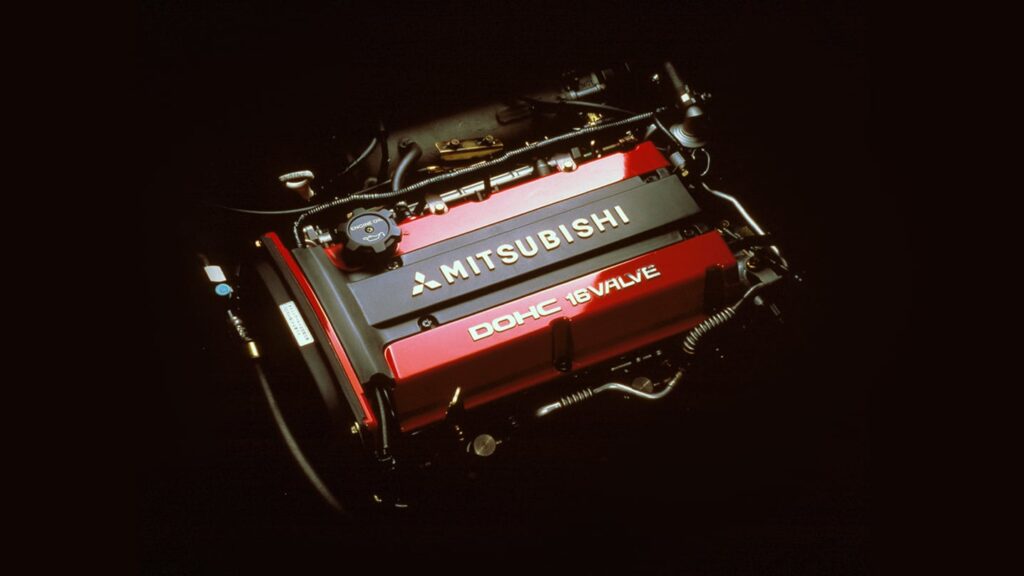
The Mitsubishi 4G63 engine is a paragon of internal combustion engineering, boasting an architecture designed for resilience and performance. At its core, the engine features a robust iron block that underpins its durability. Using an alloy head contributes to its lighter weight and better heat dissipation, which is critical for maintaining performance under stress.
Key Features:
- Iron Block Construction: Provides a sturdy foundation that can handle increased power and torque.
- Alloy Cylinder Head: Reduces weight and enhances thermal efficiency.
- Dual Overhead Camshafts (DOHC): Allows for more precise valve timing, improving airflow and combustion efficiency.
- Turbocharging: With a factory-fitted turbocharger, the 4G63 offers substantial power boosts while maintaining compact dimensions.
- 4 Valves per Cylinder: Increases the engine’s breathing capability, resulting in better fuel mixture intake and exhaust gas expulsion.
- Forged Components: Forged pistons and connecting rods enhance strength and allow for higher performance tuning in many models.
Innovations:
- MIVEC Technology: Mitsubishi’s Innovative Valve timing Electronic Control system, adopted in later versions, optimizes valve timing for improved power delivery and fuel economy.
- Intercooling System: Ensures charge air is cooled for increased density, enhancing combustion and power output.
The 4G63’s design and features have rendered it versatile across various applications, from the rally-bred Lancer Evolution to various other road-going models. This engine is a testament to Mitsubishi’s innovative spirit and commitment to producing exciting and enduring engines.
What Cars Have A Mitsubishi 4G63 Engine?
| Model | Years Produced |
|---|---|
| Nissan Pulsar NX SE (USA and Canada) | – |
| Nissan EXA (Australia and Japan) | – |
| Nissan Skyline 1800I (HR31),(Japan) | 1985-1991 |
| Nissan Silvia (S13) | 1989-1990 |
| Nissan Sunny N13 (UK) | – |
| Nissan Sunny B12 Coupe (UK) | – |
| Nissan Bluebird T72 (UK) | – |
| Nissan Bluebird | 1987-1989 |
| Nissan Auster | 1985-1990 |
| Nissan EXA (Australia) | 1988-1991 |
Engine Reliability and Longevity
When discussing the Mitsubishi 4G63 engine, its reliability and longevity are two attributes that are often highlighted. This engine has stood the test of time, powering vehicles from the 1980s through the 21st century with remarkable endurance.
How Reliable is the Mitsubishi 4G63 Engine?
The 4G63 has a reputation for being exceptionally reliable, thanks in part to:
- Robust Block Design: The iron block construction ensures that the engine can withstand high stress and pressures, making it less likely to crack under high performance or tuning.
- Forged Internals: Many 4G63 engines come with forged pistons and rods, which provide additional strength for high-performance applications.
- Quality Manufacturing: Mitsubishi’s precision manufacturing processes and quality control have resulted in an engine reliably delivering high performance.
Lifespan Expectations of the 4G63 Engine
With proper maintenance, the 4G63 engine is known for its longevity, often reaching or exceeding:
- High Mileage: Many owners report their 4G63 engines running strong at over 200,000 miles.
- Rally Durability: Proven track record in the punishing conditions of rally racing.
- Tuning Potential: The engine’s design accommodates performance upgrades without significantly compromising its life expectancy.
Here’s a snapshot of what contributes to the 4G63’s lifespan:
| Factor | Contribution to Longevity |
|---|---|
| Construction | Robust, with iron block |
| Internals | Forged components |
| Maintenance | Accessible and well-documented |
| Manufacturing | High Mitsubishi quality standards |
Bullet List of Longevity Features:
- Iron block capable of handling high-boost applications
- Alloy head for better cooling efficiency
- DOHC setup for precise valve control
- Turbochargers built for durability
- The wide availability of parts for maintenance and repair
In summary, the Mitsubishi 4G63 is an engine that offers an excellent balance of power, reliability, and longevity. It’s an engine built to last, with many units having surpassed the 300,000-mile mark with basic upkeep and care. Its enduring presence in competitive motorsports and the consumer market alike is a testament to its design and durability.
Common Mitsubishi 4G63 Engine Problems
Despite the Mitsubishi 4G63 engine’s reputation for durability, like any mechanical workhorse, it has a few common issues that owners should be aware of. Understanding these problems can ensure your engine runs smoothly for years to come.
Common Issues and Troubleshooting for the 4G63 Engine
The 4G63 engine’s most common problems are:
- Cracked Exhaust Manifold: The turbo’s heat can lead to manifold cracks.
- Worn Timing Belt: A snapped timing belt can cause severe engine damage as an interference engine.
- Oil Leaks: Aging seals and gaskets can lead to oil leaks, particularly around the valve cover and oil pan.
Here are troubleshooting tips for each issue:
| Common Issue | Troubleshooting Tip |
|---|---|
| Cracked Exhaust Manifold | Inspect regularly and replace if necessary. |
| Worn Timing Belt | Replace the timing belt at recommended intervals. |
| Oil Leaks | Check seals/gaskets and replace if worn. |
Tips for Maintaining Your Mitsubishi 4G63 Engine Health
- Regular Maintenance: Follow the manufacturer’s maintenance schedule.
- Quality Parts: Use OEM or high-quality aftermarket parts.
- Timely Repairs: Address issues as soon as they arise to prevent further damage.
By staying vigilant with these maintenance tips and troubleshooting common problems quickly, you can preserve the integrity and performance of your Mitsubishi 4G63 engine, ensuring it continues to be the reliable powerhouse it was designed to be.
Upgrading Your Mitsubishi 4G63 Engine
The Mitsubishi 4G63 engine, celebrated for its robust design and high power ceiling, is an ideal upgrade candidate. Whether for competitive racing or enhancing the driving experience, several key modifications can unleash the engine’s full potential.
Top Upgrades for Performance and Efficiency in the 4G63
Performance Upgrades:
- Turbochargers: Upgrading to a larger turbo can significantly increase power. A twin-scroll turbocharger offers improved response and efficiency.
- Intercoolers: A larger or more efficient intercooler reduces the temperature of the charge air, increasing density and improving combustion.
- ECU Tuning: Custom remapping of the engine’s electronic control unit (ECU) can fine-tune fuel and ignition parameters for improved performance.
- Exhaust System: High-flow exhaust systems reduce backpressure, allowing the engine to breathe more freely and produce more power.
Efficiency Improvements:
- Cold Air Intake: Installing a cold air intake system can improve efficiency by drawing in cooler, denser air.
- Fuel Injectors: Upgrading to higher capacity fuel injectors ensures adequate fuel delivery during high performance.
- Ignition System: High-performance spark plugs and ignition coils provide a stronger spark for better combustion efficiency.
Modifying Your 4G63 for Racing and Enhanced Driving Experience
Racing Modifications:
- Suspension Upgrades: Improved suspension components enhance handling to match the increased power.
- Weight Reduction: Stripping unnecessary weight can improve acceleration and agility.
- Brake Upgrades: Larger, more robust braking systems are essential for safety and performance in racing conditions.
Enhancing the Driving Experience:
- Clutch and Drivetrain: Upgraded clutches and strengthened drivetrains cope with increased torque.
- Aerodynamics: Body kits and spoilers can improve downforce and stability at high speeds.
Maintenance Post-Upgrade:
- Regular Checks: Frequent inspections and maintenance become even more crucial after modifications.
- Professional Installation: Ensure upgrades are installed by professionals for safety and reliability.
With these upgrades, your 4G63 will deliver breathtaking performance and exhibit enhanced efficiency. Such modifications can transform an already impressive engine into an automotive powerhouse, capable of delivering exhilarating speed and handling that can dominate on the track or provide an exceptional driving experience on the road.
Should I Build My Engine To Handle More Power Than I Expect To Need, To Build In Room For Future Power Growth?
It is not uncommon for customers to ask the question, “Exactly what can this engine be tailored to?” The quick answer might seem like we could go nuts with tuning-“just make it handle any amount of power”!
The fallacy feeds through the idea that a larger-scale build will provide an engine that will last longer. In reality, a smaller stage 1 engine has its place and purpose. A tighter piston-to-wall clearance and less ring gap won’t typically destabilize the piston on startup, which is a common forged piston cold start artifact.
Forged pistons expand when under heat but also contract during cold. When a piston warms up from running a temperature, it expands to its full size again. Until this happens, the larger piston clearance means that the piston will rattle in the bore of an engine block and cause damage to both parts via attrition over time.
As a general rule of thumb for building engines for maximum longevity, we recommend a build that suits your goals and needs while maintaining good power performance.
What Combination Is Best, And Why Should I Choose It?
One of the most popular upgrades for modern cars is swapping their powerplant with a newer, more powerful model. The user is given four different engines to choose from, and this article outlines their specific pros and cons in detail.
2.0l 4G63 engine
Pros: High revving with good rod ratio
Cons: Evo blocks are harder to track down, so there is no option for an extra displacement. They also have the same exhaust energy as other blocks within their class.
2.3 4G63-based “Stroker” engine
Pros: Easy displacement that bolts in where the 2.0l goes without any modifications
Cons: The 4G63 engine features a shorter rod, which may increase piston wear compared to other engines. This is troubling because these blocks are scarce, and it does not seem possible for Mitsubishi to produce more of them.
2.4 4G64-based engine
Pros: Big displacement with minimal rod ratio loss for the longevity of the bore. 4G64 block cores are easy to come by and vastly less expensive.
Cons: A high-performance engine with a 6mm taller block requires that the head be degreed and cam gears are adjusted for optimum efficiency.
A fully detailed review of this engine is required, as it has many important specifications to cover.
Engine Firing Order and Timing
The firing order of an engine is pivotal for smooth operation and optimal performance. For the Mitsubishi 4G63 engine, the firing order is set as 1-3-4-2. This sequence is carefully designed to balance the engine’s power delivery and minimize vibration, which is particularly important for the smooth running of a high-performance engine like the 4G63.
Understanding the firing order is crucial for tasks such as troubleshooting misfires, installing new spark plugs, or performing a tune-up. The precise order ensures that each cylinder fires at the right time, maintaining the engine’s balance and efficiency.
As for the timing mechanism, the 4G63 engine utilizes a timing belt. The belt synchronizes the crankshaft and camshaft rotations, ensuring that the engine’s valves open and close at the correct intervals. The belt must be in good condition and properly tensioned to avoid timing issues that could potentially lead to engine damage.
The 4G63 is known as an interference engine, meaning that if the timing belt fails, the valves can collide with the pistons, often resulting in significant engine damage. Therefore, it must adhere to Mitsubishi’s recommended timing belt replacement intervals to prevent such catastrophic failures. Regular inspections and timing belt maintenance are non-negotiables for preserving the engine’s integrity and performance.
Oil Specifications for Mitsubishi 4G63
The lifeblood of any engine is its oil, serving as a lubricant, coolant, and cleaner. For the Mitsubishi 4G63 engine, selecting the correct oil type and adhering to proper oil change intervals is key to maintaining its legendary performance and reliability.
Recommended Oil Types and Capacities for the 4G63 Engine
Mitsubishi recommends using a high-quality 10W-30 synthetic oil for standard driving conditions. However, those operating the engine under more demanding circumstances, such as in motorsports, may benefit from a thicker oil like 10W-40 to provide extra protection.
The 4G63 engine typically has an oil capacity of approximately 4.5 liters (4.76 quarts), but it’s always best to check the specific volume for your model and year to ensure accuracy.
Oil Change Intervals and Best Practices
For peak engine health, oil changes should be conducted every 3,000 to 5,000 miles if using conventional oil or every 7,500 to 10,000 miles with synthetic oil. These intervals can vary based on driving habits and conditions, so consult your owner’s manual or a professional mechanic for guidance.
Consistent oil changes flush out contaminants and prevent the buildup of sludge, which can hamper performance and lead to premature engine wear. Replacing the oil filter with each oil change is also advisable to ensure the system remains debris-free. By following these best practices, your 4G63 engine will continue to operate smoothly, mile after mile.
Mitsubishi 4G63: Interference or Non-Interference Engine?
The Mitsubishi 4G63 engine, renowned for its deployment in various performance-oriented vehicles, is categorized as an interference engine. This classification is crucial for understanding the relationship between the engine’s pistons and valves and the implications for maintenance practices.
Defining the 4G63’s Engine Type: Interference or Non-Interference?
An interference engine is designed to intersect the valve’s path with the piston’s trajectory. While this allows for higher compression ratios and better efficiency, it also means that if the timing belt or chain fails, the valves and pistons can collide. The Mitsubishi 4G63 utilizes this design to optimize its power and efficiency but at the cost of potential engine damage if the timing belt is not adequately maintained.
What This Means for Your Engine’s Maintenance
The interference nature of the 4G63 engine underscores the necessity of diligent timing belt maintenance. Mitsubishi typically recommends replacing the timing belt every 60,000 to 75,000 miles. However, this interval may vary based on the vehicle’s specific model year and usage conditions.
Adhering to these maintenance intervals is not just a suggestion; preventing catastrophic engine damage is imperative. If the timing belt were to break or skip, the resulting valve-to-piston contact could necessitate a complete engine overhaul or replacement.
As such, owners should observe the recommended service intervals and consider the quality of the timing belt and the mechanic’s expertise in performing the replacement.
Fuel Efficiency Insights
Understanding and optimizing the fuel consumption rates of the Mitsubishi 4G63 engine can lead to a more economical and environmentally friendly driving experience. Here’s what you need to know about the fuel efficiency of the 4G63 engine and how to maximize your miles per gallon (MPG).
Fuel Consumption Rates for the Mitsubishi 4G63 Engine
The 4G63, while known for its performance capabilities, also offers reasonable fuel efficiency for a turbocharged engine. On average, vehicles equipped with this engine can expect:
- City Driving: Approximately 18-20 MPG
- Highway Driving: Approximately 24-26 MPG
These figures can vary based on driving conditions, maintenance, and modifications to the engine.
Maximizing MPG in Your 4G63-Powered Vehicle
To ensure you’re getting the best fuel efficiency possible from your 4G63 engine, consider the following tips:
- Regular Maintenance: Keep your engine in top shape with regular tune-ups and oil changes.
- Tire Pressure: Maintain proper tire pressure to reduce rolling resistance.
- Driving Habits: Adopt a smooth driving style, avoiding aggressive acceleration and braking.
- Weight Reduction: Remove unnecessary weight from the vehicle to improve MPG.
- Aerodynamics: Install aerodynamic enhancements to reduce drag.
Bullet List of Efficiency Tips:
- Keep the engine tuned and serviced.
- Check tire pressures monthly.
- Use the recommended fuel grade.
- Avoid excessive idling.
- Plan trips to avoid heavy traffic.
Following these tips and being mindful of how you drive can significantly impact your 4G63’s fuel consumption, saving money at the pump and reducing your carbon footprint.
The accompanying infographic provides a visual summary and additional tips to help you enhance the fuel efficiency of your 4G63-powered vehicle.
Spark Plugs and Gapping for the 4G63
Selecting the right spark plugs and ensuring they are gapped correctly is crucial for the performance and efficiency of the Mitsubishi 4G63 engine. The ideal spark plug for the 4G63 should be capable of handling high heat and stress, especially in turbocharged applications.
Choosing the Right Spark Plugs for Your Mitsubishi 4G63
For the 4G63 engine, high-quality iridium or platinum spark plugs are typically recommended due to their durability and ability to maintain a sharp spark edge over many miles of use. These materials can withstand high combustion temperatures better and provide consistent ignition, leading to smoother engine performance and improved fuel economy.
Correct Spark Plug Gap Settings for Optimal Performance
The spark plug gap is critical for proper engine operation. For the 4G63 engine, the recommended spark plug gap typically ranges from 0.7 to 0.8 millimeters (0.028 to 0.031 inches). However, this can vary depending on your vehicle’s specific model and the type of spark plug used. Always check the service manual or consult with a professional to determine the correct gap for your setup.
Here are a few tips to ensure optimal performance:
- Use a feeler gauge to measure and set the gap accurately.
- Re-gap your spark plugs periodically, as the gap can change with wear.
- When installing new spark plugs, apply anti-seize to the threads and torque them to the manufacturer’s specifications.
Horsepower Capabilities
The Mitsubishi 4G63 engine is a legend in horsepower capabilities, offering a solid foundation for stock performance and enhanced tuning. In stock form, the 4G63’s horsepower ratings can vary widely, typically ranging from 200 to 280 horsepower, depending on the model and specific application. However, the true allure of this engine lies in its potential for modifications that can significantly increase its power output.
Horsepower Ratings and Enhancements for the 4G63 Engine
For those looking to unlock the full potential of their 4G63, the aftermarket provides a plethora of performance parts and tuning options. Upgrades like larger turbochargers, intercoolers, high-flow fuel injectors, performance camshafts, and custom ECU tuning can propel the horsepower well into the 400-500 range, with some builds reaching over 1,000 horsepower for drag racing purposes.
Unlocking the Full Potential of Your 4G63’s Horsepower
To safely and effectively increase the horsepower of a 4G63 engine, it’s essential to:
- Upgrade supporting components such as the fuel, exhaust, and cooling systems to handle the increased power.
- Ensure the engine internals are strong enough to withstand the higher power levels, which might involve upgrading to forged pistons and rods.
- Consult with experienced tuners who can customize the engine mapping to optimize performance while maintaining reliability.
By carefully selecting enhancements and tuning the 4G63, enthusiasts can experience a dramatic improvement in power, transforming their vehicles into high-performance machines capable of remarkable acceleration and speed.
Cooling System and Air Filtration
The cooling system and air filtration significantly influence the Mitsubishi 4G63 engine’s performance and longevity. Maintaining the engine coolant and ensuring effective air filtration are essential to the engine’s health.
Best Practices for Engine Coolant in the Mitsubishi 4G63
Engine Coolant Selection and Maintenance:
- Type of Coolant: Use the coolant type recommended by Mitsubishi, which typically has a higher boiling point and better heat transfer properties suitable for high-performance engines.
- Coolant Changes: Regularly change the coolant (usually every 2 years or 24,000 miles) to prevent corrosion and buildup in the cooling system.
- System Checks: Routinely inspect the radiator, hoses, and clamps for leaks or wear and ensure the radiator cap seals properly to maintain system pressure.
Cooling System Upgrades:
- Performance Radiators: Consider a larger or more efficient radiator if you push the engine beyond stock power levels.
- Thermostat: Installing a high-performance thermostat can help maintain optimal operating temperatures.
Importance of Air Filtration for Your 4G63 Engine
Air Filter Maintenance:
- Regular Replacement: Replace air filters according to the service schedule, or more frequently in dusty conditions, to ensure proper airflow.
- Upgrade Options: For tuned engines, high-flow air filters can provide better performance without compromising filtration.
Ensuring Clean Airflow:
- Intake System Checks: Regularly check the intake pipes and hoses for any obstructions or leaks that could disrupt airflow.
- Consider Environment: Be aware of the driving environment; harsh conditions require more frequent air filter changes.
By adhering to these best practices for coolant maintenance and air filtration, you can help your 4G63 engine maintain its cool even under strenuous conditions and ensure it breathes as cleanly and efficiently as possible.
Proper attention to these areas can result in smoother engine operation, optimized fuel efficiency, and reduced overheating and mechanical wear likelihood.
FAQs
What is the recommended oil type for the Mitsubishi 4G63 engine?
For the 4G63 engine, Mitsubishi typically recommends a high-quality 10W-30 synthetic oil for general use. However, the best oil for your engine may vary based on your climate and driving conditions.
How often should the timing belt be replaced on the 4G63?
Mitsubishi advises that the timing belt on a 4G63 engine should be replaced every 60,000 to 75,000 miles to prevent the risk of severe engine damage, especially since it’s an interference engine.
Is the 4G63 engine turbocharged?
Yes, many versions of the 4G63 engine are turbocharged, providing significant power and torque increases over naturally aspirated variants.
Can the 4G63 engine be used for racing?
Absolutely. The 4G63 engine is famed for its use in rally and drag racing, and with the right modifications, it can be a formidable powerplant on any race track.
What is the firing order of the 4G63 engine?
The firing order for the 4G63 engine is 1-3-4-2.
What are the common problems with the 4G63 engine?
While the 4G63 is known for reliability, common issues include cracked exhaust manifolds, worn timing belts, and oil leaks. Regular maintenance can prevent or mitigate these problems.
How can I improve the fuel efficiency of my 4G63 engine?
Maintaining proper tire pressure, ensuring regular engine maintenance, and adopting smooth driving habits can improve fuel efficiency.
What modifications can increase the performance of the 4G63?
Popular performance modifications include turbocharger upgrades, ECU tuning, performance camshafts, and improved intake and exhaust systems.
How durable is the 4G63 engine?
With proper maintenance, the 4G63 is an extremely durable engine, with many examples surpassing 200,000 miles without major issues.
Is the 4G63 an interference engine?
Yes, the 4G63 is an interference engine, meaning that the valves and pistons occupy the same space inside the cylinder, though not simultaneously. This design improves efficiency but necessitates strict adherence to timing belt replacement schedules.
Final Thoughts
To truly maximize the potential of your 4G63, regular maintenance and strategic upgrades are essential. Adherence to scheduled servicing, the use of quality parts, and timely attention to repairs will ensure that your engine continues to deliver its best performance.
For those seeking to enhance their engine, a thoughtful selection of upgrades, professional tuning, and understanding the limits of modification will allow for performance improvements without sacrificing the engine’s integrity.
The legacy of the 4G63 is not just a tale of technical specifications and performance figures; it is a story of an engine that became a part of people’s lives, an integral component of cars that enthusiasts built, raced, and cherished. It’s an engine that has seen generations of drivers and has evolved with the times while maintaining its core durability and performance attributes.
The 4G63 has powered vehicles with written history on rally stages, the drag strip, and the street. It has formed a community of passionate individuals who speak a common language of RPMs and turbo spools. As Mitsubishi evolves and the automotive landscape changes, the 4G63 remains a symbol of a bygone era of mechanical ingenuity and a beacon for those who appreciate the art of engine design and performance tuning.


